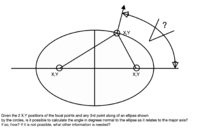You are using an out of date browser. It may not display this or other websites correctly.
You should upgrade or use an alternative browser.
You should upgrade or use an alternative browser.
How to find the angle between the major axis and N-ray of an ellipse.
- Thread starter Tom-
- Start date
LCKurtz
Full Member
- Joined
- May 3, 2019
- Messages
- 475
The standard equation of an ellipse with major axis in the x direction is [MATH]\frac{x^2}{a^2}+ \frac{y^2}{b^2}=1[/MATH]. The focal distance equation is [MATH]c^2 = a^2-b^2[/MATH]. The gradient of the left side of the equation of the ellipse is [MATH]\vec N =\langle \frac{2x}{a^2},\frac{2y}{b^2}\rangle[/MATH] and is perpendicular to the ellipse at [MATH](x,y)[/MATH]. Now, if you know [MATH]\vec N[/MATH], you can find the angle you need. Looking at what you are given and what you need, what are your thoughts?
Rather than using the focal points as inputs, could I save a step using the overall width and height of the ellipse as inputs?
This problem is my own and if I do not need the focal points to solve this I'd prefer to simplify the problem.
The back ground to this question and myself...
Solving this problem will allow me to build it into a spreadsheet where I can solve thousands of these and thus allow the configuration of a tool path on a machine with an overall elliptical form.
I'm not terrifically math savvy, but am willing to learn. I feel like I could work this out if I had graphics that explained the voids in my knowledge.
Maybe it would be better to ask; what is the best approach to this solution?
It seems the focal distance equation may be unnecessary...?
This problem is my own and if I do not need the focal points to solve this I'd prefer to simplify the problem.
The back ground to this question and myself...
Solving this problem will allow me to build it into a spreadsheet where I can solve thousands of these and thus allow the configuration of a tool path on a machine with an overall elliptical form.
I'm not terrifically math savvy, but am willing to learn. I feel like I could work this out if I had graphics that explained the voids in my knowledge.
Maybe it would be better to ask; what is the best approach to this solution?
It seems the focal distance equation may be unnecessary...?
Last edited:
LCKurtz
Full Member
- Joined
- May 3, 2019
- Messages
- 475
If you know the lengths of the major and minor semiaxes, [MATH]a[/MATH] and [MATH]b[/MATH], the vector [MATH]\vec N[/MATH] I gave you in post #2 is all you need. You can leave out the 2's and use [MATH]\vec N = \langle \frac{x}{a^2},\frac{y}{b^2}\rangle[/MATH]. Then [MATH]\tan\theta = \frac{yb^2}{xa^2}[/MATH]. You can calculate for as many (x,y) points along the ellipse as you need.
I''l try this in word form to show my interpretation.
major semi is 4
minor semi is 2
random point on the ellipse is x2.0029 y1.7312
Nray equals 2.0029 divided by 16--->0.12518125 and 1.7312 divided by 4--->0.4328
tan theta = (0.4328 times 4 ) / (1.7312 times 16)
tan theta = 1.7312 divided by 2.0029
tan theta = 0.86435
The knowledge gap here is huge. ugh
If tan theta is 0.86435 then I don't see the value...
major semi is 4
minor semi is 2
random point on the ellipse is x2.0029 y1.7312
Nray equals 2.0029 divided by 16--->0.12518125 and 1.7312 divided by 4--->0.4328
tan theta = (0.4328 times 4 ) / (1.7312 times 16)
tan theta = 1.7312 divided by 2.0029
tan theta = 0.86435
The knowledge gap here is huge. ugh
If tan theta is 0.86435 then I don't see the value...
LCKurtz
Full Member
- Joined
- May 3, 2019
- Messages
- 475
You can use Excel's atan2 function to get the angle from the formula. I have attached a little spreadsheet to show you the idea. You input the semi axis values in the green cells, and any x values you want in the first column. The yellow cells are all calculated, so don't put anything in them. The first row illustrates your x value of 2.0029. You can copy the formulas down as many rows as you want. I have just included formulas for the top half of the ellipse. Play with it and let me know if you need more help.
I just discovered that this site won't let me upload a spreadsheet with .xlsx. If you would like to PM me with your email address, I will email it to you. I don't know why I can't just attach it here.
I just discovered that this site won't let me upload a spreadsheet with .xlsx. If you would like to PM me with your email address, I will email it to you. I don't know why I can't just attach it here.
LCKurtz
Full Member
- Joined
- May 3, 2019
- Messages
- 475
Yes! It works beautifully and is a solution I couldn’t have hoped to ever solve on my own. Thank you-sincerely.
I have gotten very busy with other pursuits and have not yet tried to solve for the other half but hope it is something I can come up with when it is time.
You are very kind to help folks with such things LCKurtz!
Tom-
I have gotten very busy with other pursuits and have not yet tried to solve for the other half but hope it is something I can come up with when it is time.
You are very kind to help folks with such things LCKurtz!
Tom-

